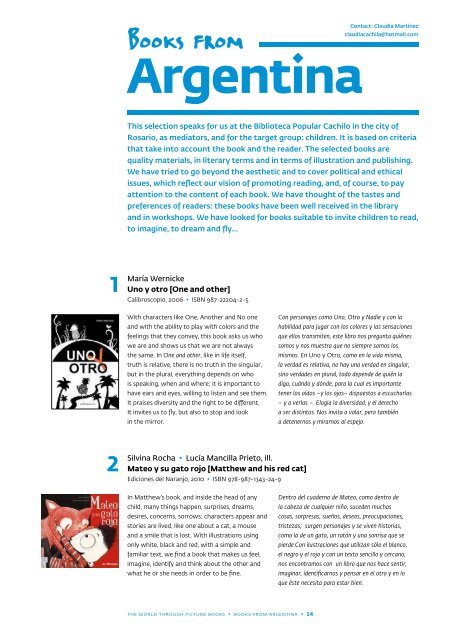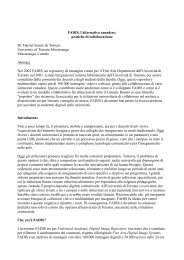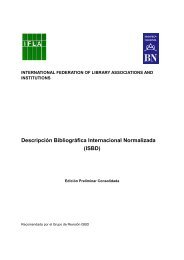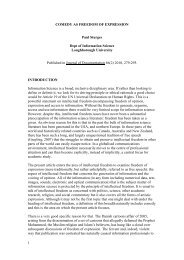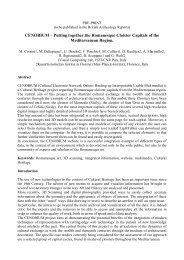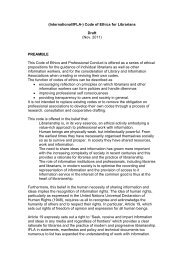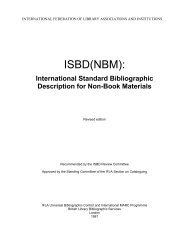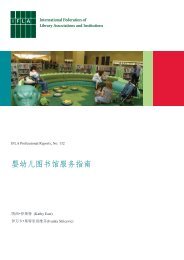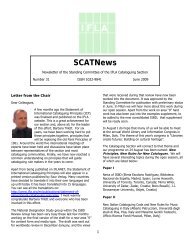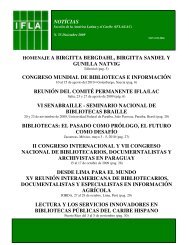English - IFLA
English - IFLA
English - IFLA
You also want an ePaper? Increase the reach of your titles
YUMPU automatically turns print PDFs into web optimized ePapers that Google loves.
1<br />
2<br />
Books from<br />
Argentina<br />
This selection speaks for us at the Biblioteca Popular Cachilo in the city of<br />
Rosario, as mediators, and for the target group: children. It is based on criteria<br />
that take into account the book and the reader. The selected books are<br />
quality materials, in literary terms and in terms of illustration and publishing.<br />
We have tried to go beyond the aesthetic and to cover political and ethical<br />
issues, which reflect our vision of promoting reading, and, of course, to pay<br />
attention to the content of each book. We have thought of the tastes and<br />
preferences of readers: these books have been well received in the library<br />
and in workshops. We have looked for books suitable to invite children to read,<br />
to imagine, to dream and fly...<br />
María Wernicke<br />
Uno y otro [One and other]<br />
Calibroscopio, 2006 • ISBN 987-22204-2-5<br />
With characters like One, Another and No one<br />
and with the ability to play with colors and the<br />
feelings that they convey, this book asks us who<br />
we are and shows us that we are not always<br />
the same. In One and other, like in life itself,<br />
truth is relative, there is no truth in the singular,<br />
but in the plural, everything depends on who<br />
is speaking, when and where; it is important to<br />
have ears and eyes, willing to listen and see them.<br />
It praises diversity and the right to be different.<br />
It invites us to fly, but also to stop and look<br />
in the mirror.<br />
Silvina Rocha • Lucía Mancilla Prieto, ill.<br />
Mateo y su gato rojo [Matthew and his red cat]<br />
Ediciones del Naranjo, 2010 • ISBN 978-987-1343-24-9<br />
In Matthew’s book, and inside the head of any<br />
child, many things happen, surprises, dreams,<br />
desires, concerns, sorrows; characters appear and<br />
stories are lived, like one about a cat, a mouse<br />
and a smile that is lost. With illustrations using<br />
only white, black and red, with a simple and<br />
familiar text, we find a book that makes us feel,<br />
imagine, identify and think about the other and<br />
what he or she needs in order to be fine.<br />
the world through picture books • books from argentina • 14<br />
Contact: Claudia Martínez<br />
claudiacachila@hotmail.com<br />
Con personajes como Uno, Otro y Nadie y con la<br />
habilidad para jugar con los colores y las sensaciones<br />
que ellos transmiten, este libro nos pregunta quiénes<br />
somos y nos muestra que no siempre somos los<br />
mismos. En Uno y Otro, como en la vida misma,<br />
la verdad es relativa, no hay una verdad en singular,<br />
sino verdades en plural, todo depende de quién la<br />
diga, cuándo y dónde, para lo cual es importante<br />
tener los oídos –y los ojos– dispuestos a escucharlas<br />
– y a verlas –. Elogia la diversidad, y el derecho<br />
a ser distintos. Nos invita a volar, pero también<br />
a detenernos y mirarnos al espejo.<br />
Dentro del cuaderno de Mateo, como dentro de<br />
la cabeza de cualquier niño, suceden muchas<br />
cosas, sorpresas, sueños, deseos, preocupaciones,<br />
tristezas; surgen personajes y se viven historias,<br />
como la de un gato, un ratón y una sonrisa que se<br />
pierde.Con ilustraciones que utilizan sólo el blanco,<br />
el negro y el rojo y con un texto sencillo y cercano,<br />
nos encontramos con un libro que nos hace sentir,<br />
imaginar, identificarnos y pensar en el otro y en lo<br />
que éste necesita para estar bien.<br />
3<br />
4<br />
5<br />
Claudia Legnazzi<br />
Tuk es Tuk [Tuk is Tuk]<br />
Ediciones del Eclipse, 2007 • ISBN 978-987-9011-71-3<br />
Tuk inhabits a varied world, with its own laws,<br />
full of strange characters and objects.But who<br />
is Tuk? Is it a person? Is it an animal? The author<br />
and illustrator, one of the most recognized artists<br />
for children in Argentina, provides us with a story<br />
beyond the formal body of the book, told by her<br />
through both textual and paratextual elements.<br />
The words take form and, together with the<br />
illustration and the book as a whole, show the<br />
importance and richness of being different, and<br />
remind us that as Tuk is Tuk, each reader is unique.<br />
Laura Devetach • Juan Lima, ill.<br />
La hormiga que canta [The ant who sings]<br />
Ediciones del Eclipse, 2004 • ISBN 987-9011-62-7<br />
Ants play, sing and leave us a path of verses and<br />
leaves. Chimichurri, chimichurri, chimichurri...<br />
slowly and rhythmically, like ants walking,<br />
the words with which the author composes<br />
these poems get together. Meanwhile, the<br />
illustrator plays with black, green and ochre in<br />
a dance of ants and leaves. In this book, John<br />
and Laura’s ants sing to us and bring and take<br />
sheets... and verses. What page, what branch,<br />
what plan shall set it up?<br />
Luis Pescetti • O’Kif, ill.<br />
Caperucita Roja (tal como se la contaron a Jorge)<br />
[Little Red Riding Hood (as it was told to Carlos)]<br />
Alfaguara Infantil, 2009 • ISBN 978-987-04-0140-7<br />
While his mother is not at home, George’s dad<br />
tells him the story of Little Red Riding Hood<br />
in the common version. However, the child’s<br />
imagination makes a very different character<br />
and a very different story: a self-assured<br />
girl, a superhero father and so on. The most<br />
interesting thing is that this dispute of imaginary<br />
characters is shown through the pictures. It is a<br />
modern day version of Little Red Riding Hood,<br />
through the eyes of a child. It’s a classic with<br />
a twist. We read it as a challenge to devour,<br />
laugh and serve us on a platter.<br />
the world through picture books • books from argentina • 15<br />
Tuk habita un mundo variado, con leyes propias, lleno<br />
de personajes y objetos extraños. ¿Pero quién es Tuk?<br />
¿Una persona? ¿Un animal? La autora e ilustradora<br />
– una de las más reconocidas artistas para niños<br />
en Argentina – nos brinda una historia más allá del<br />
cuerpo formal del libro, nos la cuenta tanto a través<br />
de lo textual como de lo paratextual. Las palabras<br />
adoptan formas y, junto con la ilustración y el libro en<br />
su conjunto, nos muestran la importancia y la riqueza<br />
de ser diversos, y nos recuerdan que así como Tuk es<br />
Tuk, cada lector es único e irrepetible.<br />
Las hormigas juegan, cantan, nos van dejando un<br />
camino de versos y hojas. Chimichurri, chimichurri,<br />
chimichurri… despacito y rítmicamente, como el<br />
caminar de las hormigas, se van juntando las palabras<br />
con que la autora compone estos poema. Mientras,<br />
el ilustrador juega con los negros, verdes y ocres en<br />
una danza de hormigas y hojas. En este libro, las<br />
hormigas de Juan y Laura nos van cantando mientras<br />
traen y llevan hojas… y versos, ¿en que hoja, de que<br />
rama, de que planta, lo armarán?<br />
Mientras la mama no está, el papá le cuenta a Jorge<br />
la historia de Caperucita Roja en una versión muy<br />
correcta. Sin embargo, la imaginación del niño convierte<br />
al personaje en otro muy diferente: de una Caperucita<br />
obediente a una niña segura, que atraviesa el bosque<br />
sin miedo y un padre superhéroe y mediático que firman<br />
autógrafos; hasta un niño dispuesto a comerse al lobo.<br />
Lo interesante es que esta disputa de imaginarios<br />
se juega en las ilustraciones. Un libro para contar<br />
Caperucita en nuestros tiempos, con ojos de niño.<br />
Un clásico con una vuelta de tuerca. Leerlo nos plantea<br />
un desafío como partícipes privilegiados para devorar,<br />
reir y servirnos en bandeja.


